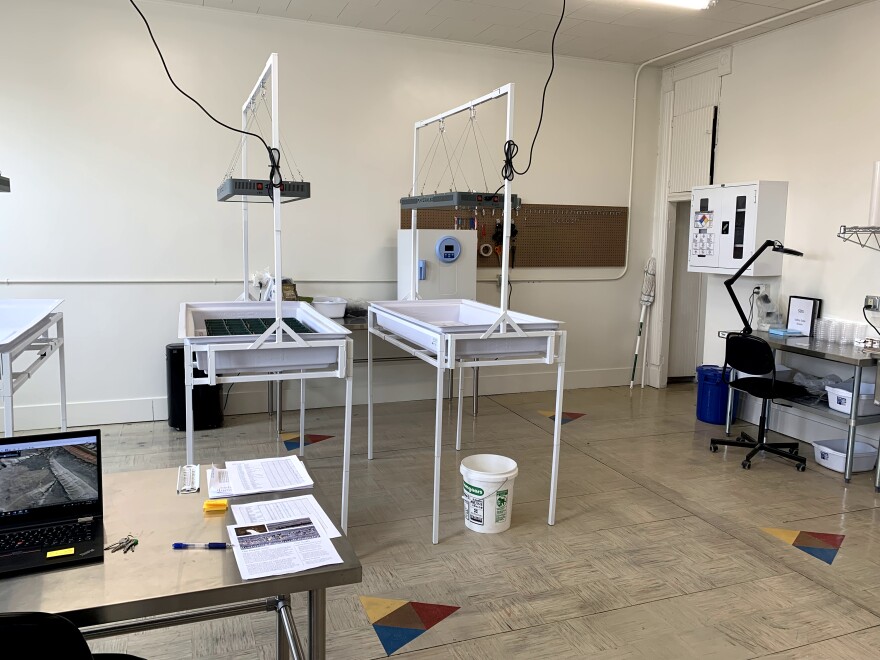Several dogs pat happily through snow-packed grass on Red Canyon Ranch in central Wyoming. It's backed by rolling hills and grazing cows. Maggie Eshleman, a Nature Conservancy restoration scientists, jumps out of her truck. She's interested in Red Canyon because of something that happened here nearly 20 years ago.
"In 2002, there was a wildfire. It was started by lightning, so it was a natural fire. It burned down onto BLM land," Eshleman said.
The blaze scarred the land, burning away the native sagebrush and other species that rely on it. Sagebrush is slow to grow back and was replaced by invasive species like cheat-grass.
She said the Nature Conservancy wants to find a way to make the native vegetation the more competitive and resilient seed, and that soon could happen with the help of a new seed technology. An experiment is underway on a plot in the distance here at Red Canyon, planted last fall.
"As you go up the hill there is some state trust land then BLM land," Eshleman said. "Our plots are kind of at the transition from state trust land onto BLM land."
The plot is growing sagebrush, but not with bare seeds buried underground like you might expect. They're encapsulated in an ear-plug sized pellet called seed-pods. It's a fertilizer, clay, nutrient concoction formed specially to help the seeds survive. It could help native seeds grow not only at Red Canyon, but across the many disturbed rangelands west-wide. That includes abandoned mine sites - there are thousands in Wyoming.

Eshleman is spearheading the seed pod project for the Nature Conservancy, but it's supported by Wyoming's Department of Environmental Quality and the U.S. Bureau of Land Management (BLM) support it. Gina Clingerman, the BLM's abandoned mine land archaeologist, explained why this project is important.
"We started this project as a way to address the impacts that are happening to the sagebrush steppe ecosystem because it is an ecosystem that is now in great peril. It once covered half of the United States. Now, it's half of that," she said, due to wildfire and development of energy, housing, and infrastructure.
The fall of sagebrush habitat is also a loss to the hundreds of species that rely on it like sage grouse. For years, Clingerman said land was considered reclaimed if any vegetation grew back on it, even invasive grasses.
"The soil is stable, but we're not seeing the shrub land community that belonged there or was there prior to the disturbance," she said.
Nowadays, government agencies and companies are reseeding land to reclaim it and even using native seeds, but Clingerman said that status quo of just spreading bare, live seeds isn't effective.
"That pure live seed, its survival rate is 5 percent. And so, if we can increase that survival rate with the seed pods then that's that's going to help those seeds get established quicker and they're going to get a better foothold," she said.
The small, experimental plot lined with sagebrush at Red Canyon started at a seed lab in Lander.
Eshleman weaves through a dimly lit warehouse before stopping in an industrial-looking room - her seed lab. An LCD grow light hums, shining purple over tiny sagebrush sprouts. She's testing out different fertilizers.
"The ones that held the most promise then we'll try to incorporate into a pod," she said.

Theoretically, each seed pod could be used for a different purpose. Right now, Eshleman has been mixing and using a pod recipe that makes sage brush resistant to herbicides. Another seed pod recipe could insert nutrients into the soil where none was. Eshleman said that's important for abandoned mine sites.
"Wyoming soil is not the best soil in the world to begin with but due to the disturbance of the initial mining but then also the reclamation of that mine there are certain deficiencies within the soil," she said.
That's why the Nature Conservancy isn't just testing out pods at Red Canyon Ranch, but two other sites in Wyoming: both abandoned uranium mines. Eshleman said they're excited at the prospect of seed pods at those sites to once again house a healthy shrub community.
Seed pods could also help protect against too much or too little rainfall.
"[You] want to be able to, regardless of what the weather might be that spring, put seeds out and have them successfully emerge and survive," she said.
Eshleman said there's no one-size-fits-all seed pod recipe to help seeds grow even in hostile environments, but she's still in the very early stages of the project. Eventually, the goal is to use that and start to rebuild the imperiled sage brush ecosystem in Wyoming.
"If we want to keep the species around that are dependent on sagebrush and that ecosystem then we really need to make strides towards restoring it. Because at this point we're not super successful at restoring sagebrush," she said.
Eshleman will visit the Red Canyon site one more time this summer to count seedlings. Most of her time will be spent at the mine sites.
Similar projects are underway in Nevada and Oregon this summer.







